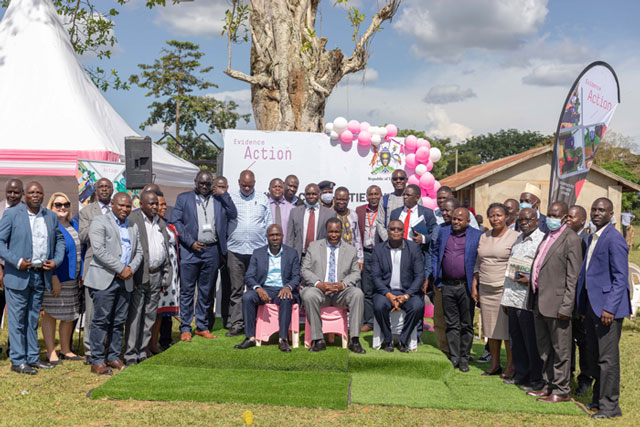
Eng. Ahmed Ssentumbwe and Emmanuel Dennis write that Government of Uganda partner Evidence Action will expand its safe water program to reach 4.4 million people in the Eastern region
SPECIAL FEATURE | September 28, 2022 Kampala, Uganda | Water is one of the most important requirements for human health and life – but it can also carry pathogens that cause infectious diseases. Unsafe water is responsible for more than 1.2 million deaths each year. It is the most common cause of diarrhea, which is in turn the world’s second-leading cause of child mortality.
The first target under Sustainable Development Goal (SDG) 6 of Clean Water and Sanitation is by 2030; achieve universal and equitable access to safe and affordable drinking water for all. However, globally over 2 billion people lack access to safely managed drinking water, including 423 million who take water from unprotected springs and wells, and 159 million who are dependent on surface water such as rivers and lakes.

The Government of Uganda continues to tackle the menace of contaminated water and has pledged to meet the SDG of safe and affordable drinking water for all by 2030. The proportion of the rural population using an improved drinking water source has increased from 65 percent in 2016 to 69 percent in 2019, and the percentage of villages with a safe water supply has risen from 64 percent in 2017 to 66 percent in 2019.
The Government recognises the efforts of our development partners, who are implementing water and sanitation programmes and projects across the country. Evidence Action is one such partner. Since 2014, their Dispensers for Safe Water programme has been working in 11 districts in Eastern Uganda to provide safe water access to approximately 1.61 million people through 5,719 chlorine dispensers placed at rural water points.
The programme is now expanding to serve an additional nine districts, providing safe water access to approximately 2.78 million additional people through 12,000 new chlorine dispensers. By the end of 2023, Dispensers for Safe Water will be providing safe water access to approximately 4.4 million Ugandans, reaching an estimated 10% of the country’s population, or 40% of the population in the Eastern Region.
Dispensers for Safe Water delivers a year’s worth of safe water access for less than UGX 5,712.00 per person. The service is free for users and the model is simple: A community member goes to their usual water source, places their bucket under the dispenser, turns the valve once to dispense the correct dose of chlorine, and fills their bucket with water as they normally would. The chlorine disinfects the water during their walk home; by the time they arrive, it is safe to drink.
The programme is supported by a last mile service delivery network of local employees, as well as volunteers who are elected by their community to guide dispenser use and advise Evidence Action when repairs or chlorine refills are needed.
In 2021, Evidence Action had 52 Ugandan employees. As of September 2022, they have over 130, with 40 additional hires to be made by year end. The programme’s chlorine dispensers will now be manufactured locally, via a new warehouse in Mbale and a contract with a Ugandan plastic injection moulding company. Evidence Action is also supporting a local chlorine manufacturer to increase its capacity to supply sodium hypochlorite for the dispensers. All of this means many more jobs for Ugandans as a result of the Dispensers for Safe Water expansion.
The expansion was catalysed by new evidence suggesting that water treatment may be one of the most cost-effective ways to help save the lives of children under five. Research by Nobel Laureate Michael Kremer and co-authors shows that water treatment reduces the odds of mortality of children under five, from all causes, by around 25%.
As part of their analysis, Kremer and colleagues also looked at implementation data from Dispensers for Safe Water; they estimate the program is over 45 times more cost-effective than the World Health Organisation’s “highly cost-effective” threshold. This puts water treatment in similar company to micronutrient interventions, insecticide-treated bednets to prevent malaria, and routine childhood vaccinations in terms of its impact on child health.
For Uganda to improve child health, our policies must consider water treatment; the Government’s partnership with Dispensers for Safe Water is an excellent step towards this goal.
The Minister of Water and Environment, Honourable Sam Cheptoris, thus proudly launched the programme’s expansion at a ceremony in the Busoga sub-region on 21 September held in Namungalwe Sub County, Iganga district.
*****
More information on the Dispensers for Safe Water programme can be found on Evidence Action’s website – www.evidenceaction.org.
Engineer Ahmed Ssentumbwe is the Assistant Commissioner Operations, Rural Water Supply in the Ministry of Water and Environment, Government of Uganda and Emmanuel Dennis is the Senior Manager Policy and Partnerships for Evidence Action, Eastern and Southern Africa Region.
 The Independent Uganda: You get the Truth we Pay the Price
The Independent Uganda: You get the Truth we Pay the Price




That’s really wonderful and everything but…
In many parts of Kampala, including some of the higher density residential areas with major sanitation issues, we have been having really long lapses in water supply that can even last the whole day.
Yet we are having an Ebola outbreak in the country and we are being told to wash hands to avoid catching Ebola… wash hands using which water?